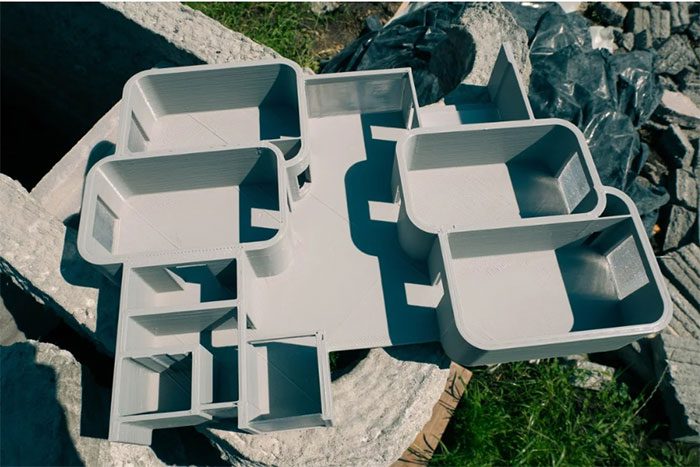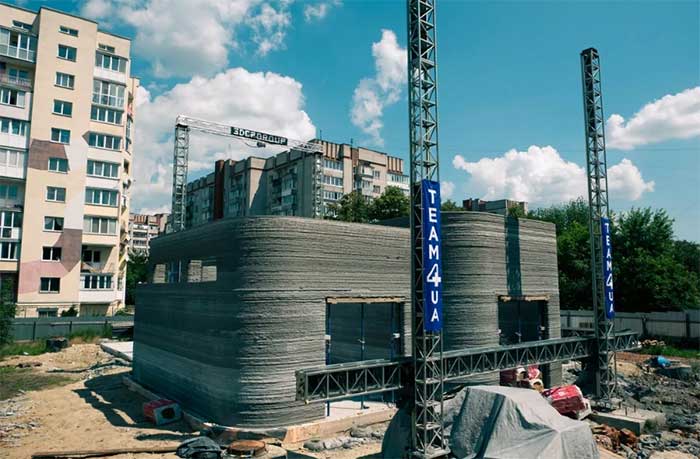In just 40 hours, the walls of the pilot project for the Lviv Primary School (Ukraine) were completed thanks to the COBOD 3D printer.
According to Jean-Christophe Bonis, the founder of Team4UA, the non-profit organization responsible for the pilot project, this is the first 3D-printed educational facility in Europe and the first 3D-printed building in a conflict zone.
“I am not a builder, nor do I want to be an architect or developer. Through robots and artificial intelligence (AI), through technology, we hope to accelerate the construction process,” Bonis said in an interview with CNN.

Model of the school with 4 classrooms designed for Lviv Primary School. (Photo: Team4UA).
Immediately after Russia launched its special military operation in Ukraine in February 2022, areas in Eastern Ukraine like Lviv Province faced a significant challenge: how to accommodate the influx of evacuees arriving in numbers of up to tens of thousands. According to the latest figures from the International Organization for Migration (IOM) of the United Nations, as of December 2023, there are 173,000 internally displaced persons in Ukraine due to the conflict.
Bonis added that the Hive project will build a school equipped with four classrooms to help accommodate students displaced by the war. He hopes that if successful, the project will allow 3D printing technology to become one of the primary construction tools in Ukraine.
Andriy Zakaliuk, head of the Lviv Department of Education, stated that the project offers an opportunity for Ukrainian children to experience a new environment. “They will begin a new phase of life in a modern environment. This is an iconic facility. These children have the opportunity to see that with the help of a 3D printer, you can build real buildings.”
Challenges of Power Outages and Bombing
Experts point out that construction using 3D printing techniques can be significantly faster and more sustainable than traditional construction methods.
Team4UA collaborated with Balbek Bureau, a Ukrainian studio, for the school’s design and the architecture firm Ars Longa for engineering. The one-story school was launched in September 2022, with the entire project, from foundation to completion, initially expected to take only three months.
However, airstrikes and bombings across the country throughout October and November 2022 targeted critical civilian infrastructure, including the power grid, causing widespread blackouts in Lviv and hindering the transportation of printing equipment.
It wasn’t until last summer that the situation in Lviv stabilized and power was fully restored, allowing the printer to operate. In less than two days, the concrete frame of the school was completed.
However, the planned opening of the facility originally set for January 2024 has once again been postponed due to funding issues, with developers needing an additional $400,000.
As a relatively new technology with limited data on the safety and stability of printed buildings, 3D-printed structures are mainly used for one-off projects or research collaborations. When it comes to large-scale construction, this technology is still in its infancy. Furthermore, although 3D printing technology has the potential to be cheaper than traditional construction methods, the initial cost of printers can be extremely high, and their size can make transportation difficult and costly.
According to Christian Lange, an Associate Professor of Architecture at the University of Hong Kong, there are cheaper and faster alternatives to 3D printing, such as prefabricated buildings and modules resembling post-World War II models that provided affordable housing to the public.

The walls were completed in just 40 hours. Photo: Team4UA
Applications of 3D Technology
Team4UA is not the only organization recognizing the potential of 3D printing in disaster-stricken and conflict areas.
Jack Oslan, CEO of Diamond Age, a construction company based in Arizona (USA), stated that the company is in discussions with Ukrainian officials about 3D printing bomb shelters and military infrastructure.
Diamond Age utilizes a 3D printing system to construct insulated walls. This design saves over 30% energy compared to wooden-framed structures and is robust enough to withstand a Category 5 hurricane or moderate earthquake.
According to a study by the Kyiv School of Economics, the damage to Ukraine’s infrastructure from the conflict, as of September 2023—including housing, schools, energy networks, and transportation systems—will require approximately $151.2 billion for replacement.
Oslan noted that 3D printing technology could significantly aid in the reconstruction efforts in Ukraine. Team4UA hopes that pilot programs can help them accelerate speed and efficiency while reducing costs for future humanitarian projects.


















































